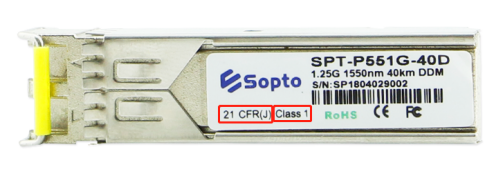1. How is the speed of the optical module calculated?
The unified standard transmission rate level of the optical module is based on the basic rate of 155.520Mb/s, also known as baistm-1.We say that the transmission speed of the optical module is a multiple of this, for example: stm-4 is a special 155.520×4=622.020Mb/s, usually 622M. The 1G optical module we usually say actually refers to 1.25G, which is stm-8, that is, 155.520×8=1244.16Mb/s.
2. What does the abbreviation DDM mean in the SFP parameters of the optical module?

DDM, or digital diagnostic monitoring, is a technology used in SFP optical modules. This technology can monitor SFP real-time data including optical output power, optical input power, temperature, laser bias current, and transceiver power supply voltage. The DDM interface can also enable end users to have fault isolation and fault prediction capabilities. Fiber optic transceivers with DDM help ensure that businesses can proactively prevent network maintenance and ensure business continuity.
3. What do the parameters in the SFP label of the optical module mean?

Take the above picture as an example, SPT-P551G-40D represents the model of this product, 1.25G represents the transmission rate, 1550nm represents the transmission wavelength; 40km represents the distance at which data can be transmitted; DDM, which supports digital diagnostic monitoring technology; Rohs, CE, FC It is in compliance with the relevant certification standards.
However, 21CFR(J) and Class1 usually pay less attention, and I believe many people do not know it. Class1 represents the laser safety level. The lower the level, the higher the safety. The laser safety level can be divided into 4 levels according to the degree of danger:
Class1: Harmless and control-free laser. The laser emitted by this level of laser has no danger to the human body during use, and it will not damage the eyes even if the eyes are used directly. No control is required for this type of laser. The laser safety level of the optical module products produced is required to reach Class1.
Class2: Low-power laser. Although the output laser power is low, it will not cause eye damage if you look at it occasionally, but it will damage the retina if you look directly at it for a long time. However, this type of laser has no thermal damage to human skin.
Class3: Medium power laser. When the output power of this kind of laser is focused, looking directly at the beam will cause eye damage. When it is not focused, it is generally not dangerous. This kind of laser has no thermal damage to the skin.
Class4: High-power laser. This type of laser not only damages eyes and skin by its direct beam and mirror-reflected beam, but also causes serious damage, and its diffuse reflected light may also cause damage to human eyes.
21CFR(J) refers to the 21CFR regulations of the US Food and Drug Administration (FDA), which can also be said to be a quality management system. This mark indicates that it can be exported to the United States. The United States requires manufacturers of laser products sold in the United States to be responsible for ensuring Laser products comply with US federal regulations. US Food and Drug Administration (FDA) regulates all laser products sold in the United States.
4. Where can the optical module be used?
Optical modules are used in photoelectric signal conversion, high-definition optical transceivers; optical fiber transceivers; switches; optical routers; olt, optical fiber network cards; base stations: in mobile communication systems, connect the fixed part and the wireless part, and communicate with the mobile station through wireless transmission in the air Connected equipment; tunnel traffic monitoring, etc., basically where optical fiber communication is involved, there will be optical modules.
5. What do the different color pull rings of the optical module mean?
Pull rings of different colors are used to distinguish wavelengths. Optical modules involve multiple wavelengths, generally 850nm, 1310nm, 1490nm, 1550nm, CWDM, DWDM, etc. The more common ones are 850nm, 1310nm, 1490nm, 1550nm. 850nm is multi-mode, suitable for short-distance transmission, generally black; 1310nm, single-mode, generally used for long-distance transportation within 40km, indicated by blue; 1490nm is indicated by purple; 1550nm is generally used for long-distance transmission within 40km, Expressed in yellow.